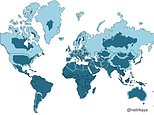
When you look at a map of the world, it makes sense to assume that Greenland and Africa are similar in size.
But in reality, the African continent is 14 times as big as the icy northern land mass.
Including a number of offshore islands, the total area of Greenland is 836,300 square miles (2.16 million square kilometres), while Africa is 11.7 million square miles (30.4 million square kilometres).
Not only that, but the latter is three times the size of North America and also significantly larger than Russia, despite the opposite appearing true when looking at a map.
So what’s going on?
Representative: This clever ‘to scale’ chart reveals the true size of Earth’s countries
Well, it turns out that many countries – including Russia, Canada and Greenland – are not nearly as big as we think and that’s because of a thing called world map distortion.
WHAT IS WRONG WITH THE MERCATOR MAP?
Africa is around 14 times larger than Greenland and yet on the map both are almost same size.
Brazil is more than five times larger than Alaska, yet Alaska is larger than Brazil on the map.
The map suggests that Scandinavian countries are larger than India, whereas in reality latter is three times the size of all them put together.
While it looks like Europe is larger than North America on this map, in reality the reverse is true.
Russia also isn’t as large as it is depicted, with Africa larger than Russia in reality.
This phenomenon can be attributed to the Mercator projection, a map most commonly seen hanging in classrooms and in text books which was created in 1596 to help sailors navigate the world.
It gives the right shapes of land masses, but at the cost of distorting their sizes in favour of the wealthy lands to the north.
Canada and Russia, for instance, appear to take up approximately 25 per cent of the Earth’s surface on a world map, when in reality they occupy a mere 5 per cent.
Australia also doesn’t appear to be that much bigger than Alaska, even though it is the world’s sixth-largest country.
In fact, it is 4.5 times bigger than Alaska.
The biggest challenge with creating a world map is that it is impossible to portray the reality of the spherical globe on a flat surface — a problem that has haunted cartographers for centuries.
As a result, shapes of world maps have typically been diverse, ranging from hearts to cones.
But the diversity gradually faded away with one model, invented by Gerardus Mercator, surpassing the others.
However, its distortion was studied by Met Office climate data scientist Neil Kaye, who created a two dimensional representation of what the world really looks like.
It illustrates how countries in the northern hemisphere are much smaller than people typically think.
The familiar Mercator projection (pictured) gives the right shapes of land masses, but at the cost of distorting their sizes in favour of the wealthy lands to the north
Africa is actually three times the size of North America and also significantly larger than Russia, despite the opposite appearing true when looking at a map (pictured)
This strange distortion has been explored by a climate data scientist at the Met Office who has created a two dimensional representation of what the world really looks like
He did this by inputting Met Office data on the sizes of each country into Ggplot, which is a data visualisation package for statistical programming.
Kaye then created the final map using a sterographic projection — a mapping function that projects a sphere onto a plane.
Mercator, who lived from 1512 to 1594, was a Flemish cartographer famous for creating a world map based on a projection which showed sailing courses of as straight lines.
Unlike other geography scholars from around the same time as him, he did not travel much.
Instead his knowledge of geography came from his library of over one thousand books and maps.
Take a look at a world map today and you’re likely to think that North America and Russia are both larger than Africa. This strange distortion has been revealed by a climate data scientist who has created a two dimensional representation of what the world really looks like (pictured)
The map was created by inputting data on the sizes of each country (right) and inputting it into Ggplot, which is a data visualisation package for the statistical programming
In the 1580s he began publishing his atlas, which he named after the giant holding the world on his shoulders in Greek mythology.
In the Mercator projection, North America looks at least as big, if not slightly larger, than Africa.
Greenland also looks of comparable size, but in reality Africa is larger than both.
In fact, you can fit north America into Africa and still have space for India, Argentina, Tunisia and some left over.
The map also suggests that Scandinavian countries are larger than India, whereas in reality the latter is three times the size of all of them put together.
WHO WAS GERARDUS MERCATOR?
Gerardus Mercator (5 March 1512 – 2 December 1594) was a Flemish cartographer famous for creating a world map based on a projection which showed sailing courses of as straight lines.
Invented in the 16th century, the ‘Mercator’ projection gives the right shapes of land masses, but at the cost of distorting their sizes in favour of the wealthy lands to the north.
Although it is what he is most famous for, Mercator was not just a geographer. He dipped his toes in theology, philosophy, history, mathematics and magnetism.
Gerardus Mercator (5 March 1512 – 2 December 1594) was a Flemish cartographer famous for creating a world map based on a projection which showed sailing courses of as straight lines
Not content with just those skills, Mercator was also an engraver, calligrapher and he even made globes and scientific instruments.
Unlike other geography scholars from around the same time as him, he did not travel much. Instead his knowledge of geography came from his library of over one thousand books and maps.
In the 1580s he began publishing his atlas, which he named after the giant holding the world on his shoulders in Greek mythology.
He suffered a series of strokes in the early 1590s, which left him partly paralysed and almost blind, until a final stroke caused his death in 1594 at the age of 82.
Source link
CHECK OUT: Top Travel Destinations
READ MORE: Travel News



